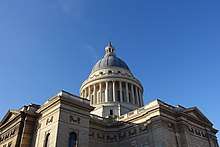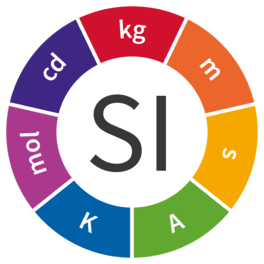Metre
The metre (Commonwealth spelling) or meter (American spelling[1]) (from the French unit mètre, from the Greek noun μέτρον, "measure") is the base unit of length in the International System of Units (SI). The SI unit symbol is m.[2] The metre is defined as the length of the path travelled by monochromatic light in a vacuum in 1/299 792 458 of a second.[3] The metre was originally defined in 1793 as one ten-millionth of the distance from the equator to the North Pole along a great circle, so the Earth's circumference is approximately 40000 km. In 1799, the metre was redefined in terms of a prototype metre bar (the actual bar used was changed in 1889). In 1960, the metre was redefined in terms of a certain number of wavelengths of a certain emission line of krypton-86. In 1983, the current definition was adopted.
| Metre | |
|---|---|
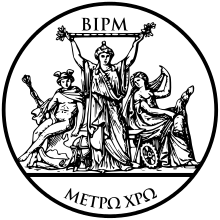 Seal of the International Bureau of Weights and Measures (BIPM) – Use measure (Greek: ΜΕΤΡΩ ΧΡΩ) | |
| General information | |
| Unit system | SI base unit |
| Unit of | length |
| Symbol | m |
| Conversions | |
| 1 m in ... | ... is equal to ... |
| SI units | 1000 mm 0.001 km |
| Imperial/US units | ≈ 1.0936 yd ≈ 3.2808 ft ≈ 39.370 in |
| Nautical units | ≈ 0.00053996 nmi |
Spelling
Metre is the standard spelling of the metric unit for length in nearly all English-speaking nations except the United States[4][5][6] and the Philippines,[7] which use meter. Other Germanic languages, such as German, Dutch, and the Scandinavian languages[8] likewise spell the word meter.
Measuring devices (such as ammeter, speedometer) are spelled "-meter" in all variants of English.[9] The suffix "-meter" has the same Greek origin as the unit of length.[10][11]
Etymology
The etymological roots of metre can be traced to the Greek verb μετρέω (metreo) (to measure, count or compare) and noun μέτρον (metron) (a measure), which were used for physical measurement, for poetic metre and by extension for moderation or avoiding extremism (as in "be measured in your response"). This range of uses is also found in Latin (metior, mensura), French (mètre, mesure), English and other languages. The motto ΜΕΤΡΩ ΧΡΩ (metro chro) in the seal of the International Bureau of Weights and Measures (BIPM), which was a saying of the Greek statesman and philosopher Pittacus of Mytilene and may be translated as "Use measure!", thus calls for both measurement and moderation. The use of the word metre (for the French unit mètre) in English began at least as early as 1797.[12]
History of definition
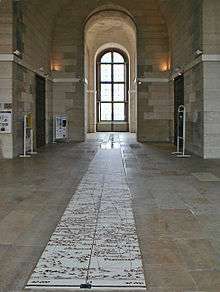
In 1671 Jean Picard measured the length of a "seconds pendulum" (a pendulum with a period of two seconds) at the Paris observatory. He found the value of 440.5 lines of the Toise of Châtelet which had been recently renewed. He proposed a universal toise (French: Toise universelle) which was twice the length of the seconds pendulum.[13][14] However, it was soon discovered that the length of a seconds pendulum varies from place to place: French astronomer Jean Richer had measured the 0.3% difference in length between Cayenne (in French Guiana) and Paris.[15][16][17]
Jean Richer and Giovanni Domenico Cassini measured the parallax of Mars between Paris and Cayenne in French Guiana when Mars was at its closest to Earth in 1672. They arrived at a figure for the solar parallax of 9.5 arcseconds, equivalent to an Earth–Sun distance of about 22000 Earth radii. They were also the first astronomers to have access to an accurate and reliable value for the radius of Earth, which had been measured by their colleague Jean Picard in 1669 as 3269 thousand toises. Picard's geodetic observations had been confined to the determination of the magnitude of the Earth considered as a sphere, but the discovery made by Jean Richer turned the attention of mathematicians to its deviation from a spherical form. In addition to its significance for cartography, the determination of the Figure of the Earth became a problem of the highest importance in astronomy, inasmuch as the diameter of the Earth was the unit to which all celestial distances had to be referred.[18][19][20][21]
Meridional definition
As a result of the French Revolution, the French Academy of Sciences charged a commission with determining a single scale for all measures. On 7 October 1790 that commission advised the adoption of a decimal system, and on 19 March 1791 advised the adoption of the term mètre ("measure"), a basic unit of length, which they defined as equal to one ten-millionth of the distance between the North Pole and the Equator along the meridian through Paris.[22][23][24][25][26] In 1793, the French National Convention adopted the proposal.[12]
The French Academy of Sciences commissioned an expedition led by Jean Baptiste Joseph Delambre and Pierre Méchain, lasting from 1792 to 1799, which attempted to accurately measure the distance between a belfry in Dunkerque and Montjuïc castle in Barcelona at the longitude of Paris Panthéon.[27] The expedition was fictionalised in Denis Guedj, Le Mètre du Monde.[28] Ken Alder wrote factually about the expedition in The Measure of All Things: the seven year odyssey and hidden error that transformed the world.[29] This portion of the Paris meridian, was to serve as the basis for the length of the half meridian connecting the North Pole with the Equator. From 1801 to 1812 France adopted this definition of the metre as its official unit of length based on results from this expedition combined with those of the Geodesic Mission to Peru.[30][31] The latter was related by Larrie D. Ferreiro in Measure of the Earth: The Enlightenment Expedition that Reshaped Our World.[32]
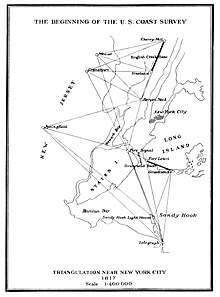
A more accurate determination of the Figure of the Earth would soon result from the measurement of the Struve Geodetic Arc (1816–1855) and would have given another value for the definition of this standard of length. This did not invalidate the metre but highlighted that progresses in science would allow better measurement of Earth's size and shape.[20] After the July Revolution of 1830 the metre became the definitive French standard from 1840. At that time it had already been adopted by Ferdinand Rudolph Hassler for the U.S Survey of the Coast.[30][33][34]
"The unit of length to which all distances measured in the Coast Survey are referred is the French metre, an authentic copy of which is preserved in the archives of the Coast Survey Office. It is the property of the American Philosophical Society, to whom it was presented by Mr. Hassler, who had received it from Tralles, a member of the French Committee charged with the construction of the standard metre by comparison with the toise, which had served as unit of length in the measurement of the meridional arcs in France and Peru. It possesses all the authenticity of any original metre extant, bearing not only the stamp of the Committee but also the original mark by which it was distiguished from the other bars during the operation of standarding. It is always designated as the Committee metre" (French : Mètre des Archives).[35]
In 1830 President Andrew Jackson mandated Ferdinand Rudolf Hassler to work out new standards for all U.S. states. According to the decision of the Congress of the United States, the British Parlementary Standard from 1758 was introduced as the unit of length.[36] Another geodesist with metrology skills was to play a pivotal role in the process of internationalization of weights and measures, Carlos Ibáñez e Ibáñez de Ibero who would become the first president of both the International Geodetic Association and the International Committee for Weights and Measures.[37]
International prototype metre bar
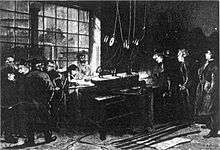
In 1867 at the second general conference of the International Association of Geodesy held in Berlin, the question of an international standard unit of length was discussed in order to combine the measurements made in different countries to determine the size and shape of the Earth.[38][39][40] The conference recommended the adoption of the metre in replacement of the toise and the creation of an international metre commission, according to the proposal of Johann Jacob Baeyer, Adolphe Hirsch and Carlos Ibáñez e Ibáñez de Ibero who had devised two geodetic standards calibrated on the metre for the map of Spain.[34][38][40][41] Measurement traceability between the toise and the metre was ensured by comparison of the Spanish standard with the standard devised by Borda and Lavoisier for the survey of the meridian arc connecting Dunkirk with Barcelona.[37][41][42]
A member of the Preparatory Committee since 1870 and Spanish representative at the Paris Conference in 1875, Carlos Ibáñez e Ibáñez de Ibero intervened with the French Academy of Sciences to rally France to the project to create an International Bureau of Weights and Measures equipped with the scientific means necessary to redefine the units of the metric system according to the progress of sciences.[43]
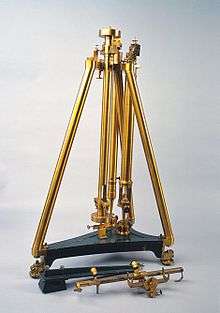
In the 1870s and in light of modern precision, a series of international conferences was held to devise new metric standards. The Metre Convention (Convention du Mètre) of 1875 mandated the establishment of a permanent International Bureau of Weights and Measures (BIPM: Bureau International des Poids et Mesures) to be located in Sèvres, France. This new organisation was to construct and preserve a prototype metre bar, distribute national metric prototypes, and maintain comparisons between them and non-metric measurement standards. The organisation distributed such bars in 1889 at the first General Conference on Weights and Measures (CGPM: Conférence Générale des Poids et Mesures), establishing the International Prototype Metre as the distance between two lines on a standard bar composed of an alloy of 90% platinum and 10% iridium, measured at the melting point of ice.[44]
The comparison of the new prototypes of the metre with each other and with the Committee metre (French: Mètre des Archives) involved the development of special measuring equipment and the definition of a reproducible temperature scale. The BIPM's thermometry work led to the discovery of special alloys of iron-nickel, in particular invar, for which its director, the Swiss physicist Charles-Edouard Guillaume, was granted the Nobel Prize for physics in 1920.[45]
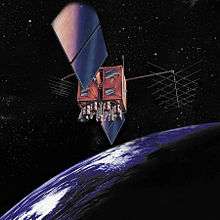
As Carlos Ibáñez e Ibáñez de Ibero stated, the progress of metrology combined with those of gravimetry through improvement of Kater's pendulum led to a new era of geodesy. If precision metrology had needed the help of geodesy, the latter could not continue to prosper without the help of metrology. Indeed, how to express all the measurements of terrestrial arcs as a function of a single unit, and all the determinations of the force of gravity with the pendulum, if metrology had not created a common unit, adopted and respected by all civilized nations, and if in addition one had not compared, with great precision, to the same unit all the standards for measuring geodesic bases, and all the pendulum rods that had hitherto been used or would be used in the future? Only when this series of metrological comparisons would be finished with a probable error of a thousandth of a millimetre would geodesy be able to link the works of the different nations with one another, and then proclaim the result of the last measurement of the Globe. As the figure of the Earth could be inferred from variations of the seconds pendulum length with latitude, the United States Coast Survey instructed Charles Sanders Peirce in the spring of 1875 to proceed to Europe for the purpose of making pendulum experiments to chief initial stations for operations of this sort, in order to bring the determinations of the forces of gravity in America into communication with those of other parts of the world; and also for the purpose of making a careful study of the methods of pursuing these researches in the different countries of Europe. In 1886 the association of geodesy changed name for the International Geodetic Association, which Carlos Ibáñez e Ibáñez de Ibero presided up to his death in 1891. During this period the International Geodetic Association (German: Internationale Erdmessung) gained worldwide importance with the joining of United States, Mexico, Chile, Argentina and Japan.[37][46][47][48][49][50]
Efforts to supplement the various national surveying systems, which begun in the 19th century with the foundation of the Mitteleuropäische Gradmessung, resulted in a series of global ellipsoids of the Earth (e.g., Helmert 1906, Hayford 1910/1924) which would later lead to develop the World Geodetic System. Nowadays the practical realisation of the metre is possible everywhere thanks to the atomic clocks embedded in GPS satellites.[51][52]
Wavelength definition
In 1893, the standard metre was first measured with an interferometer by Albert A. Michelson, the inventor of the device and an advocate of using some particular wavelength of light as a standard of length. By 1925, interferometry was in regular use at the BIPM. However, the International Prototype Metre remained the standard until 1960, when the eleventh CGPM defined the metre in the new International System of Units (SI) as equal to 1650763.73 wavelengths of the orange-red emission line in the electromagnetic spectrum of the krypton-86 atom in a vacuum.[53]
Speed of light definition
To further reduce uncertainty, the 17th CGPM in 1983 replaced the definition of the metre with its current definition, thus fixing the length of the metre in terms of the second and the speed of light:[3]
- The metre is the length of the path travelled by light in vacuum during a time interval of 1/299 792 458 of a second.
This definition fixed the speed of light in vacuum at exactly 299792458 metres per second (≈300000 km/s). An intended by-product of the 17th CGPM's definition was that it enabled scientists to compare lasers accurately using frequency, resulting in wavelengths with one-fifth the uncertainty involved in the direct comparison of wavelengths, because interferometer errors were eliminated. To further facilitate reproducibility from lab to lab, the 17th CGPM also made the iodine-stabilised helium–neon laser "a recommended radiation" for realising the metre.[54] For the purpose of delineating the metre, the BIPM currently considers the HeNe laser wavelength, λHeNe, to be 632.99121258 nm with an estimated relative standard uncertainty (U) of 2.1×10−11.[54][55][56] This uncertainty is currently one limiting factor in laboratory realisations of the metre, and it is several orders of magnitude poorer than that of the second, based upon the caesium fountain atomic clock (U = 5×10−16).[57] Consequently, a realisation of the metre is usually delineated (not defined) today in labs as 1579800.762042(33) wavelengths of helium-neon laser light in a vacuum, the error stated being only that of frequency determination.[54] This bracket notation expressing the error is explained in the article on measurement uncertainty.
Practical realisation of the metre is subject to uncertainties in characterising the medium, to various uncertainties of interferometry, and to uncertainties in measuring the frequency of the source.[58] A commonly used medium is air, and the National Institute of Standards and Technology (NIST) has set up an online calculator to convert wavelengths in vacuum to wavelengths in air.[59] As described by NIST, in air, the uncertainties in characterising the medium are dominated by errors in measuring temperature and pressure. Errors in the theoretical formulas used are secondary.[60] By implementing a refractive index correction such as this, an approximate realisation of the metre can be implemented in air, for example, using the formulation of the metre as 1579800.762042(33) wavelengths of helium–neon laser light in vacuum, and converting the wavelengths in a vacuum to wavelengths in air. Air is only one possible medium to use in a realisation of the metre, and any partial vacuum can be used, or some inert atmosphere like helium gas, provided the appropriate corrections for refractive index are implemented.[61]
The metre is defined as the path length travelled by light in a given time and practical laboratory length measurements in metres are determined by counting the number of wavelengths of laser light of one of the standard types that fit into the length,[64] and converting the selected unit of wavelength to metres. Three major factors limit the accuracy attainable with laser interferometers for a length measurement:[58][65]
- uncertainty in vacuum wavelength of the source,
- uncertainty in the refractive index of the medium,
- least count resolution of the interferometer.
Of these, the last is peculiar to the interferometer itself. The conversion of a length in wavelengths to a length in metres is based upon the relation
which converts the unit of wavelength λ to metres using c, the speed of light in vacuum in m/s. Here n is the refractive index of the medium in which the measurement is made, and f is the measured frequency of the source. Although conversion from wavelengths to metres introduces an additional error in the overall length due to measurement error in determining the refractive index and the frequency, the measurement of frequency is one of the most accurate measurements available.[65]
Timeline
- 8 May 1790 – The French National Assembly decides that the length of the new metre would be equal to the length of a pendulum with a half-period of one second.[30]
- 30 March 1791 – The French National Assembly accepts the proposal by the French Academy of Sciences that the new definition for the metre be equal to one ten-millionth of the length of a great circle quadrant along the Earth's meridian through Paris, that is the distance from the equator to the north pole along that quadrant.[66]
- 1795 – Provisional metre bar made of brass and based on Paris meridan arc (French: Méridienne de France) measured by Nicolas-Louis de Lacaillle and Cesar-François Cassini de Thury, legally equal to 443.44 lines of the toise du Pérou (a standard French unit of length from 1766).[30][31][42][52]
- 10 December 1799 – The French National Assembly specifies the platinum metre bar, presented on 22 June 1799 and deposited in the National Archives, as the final standard. Legally equal to 443.296 lines on the toise du Pérou.[52]
- 24–28 September 1889 – The 1st General Conference on Weights and Measures (CGPM) defines the metre as the distance between two lines on a standard bar of an alloy of platinum with 10% iridium, measured at the melting point of ice.[52][67]
- 27 September – 6 October 1927 – The 7th CGPM redefines the metre as the distance, at 0 °C (273 K), between the axes of the two central lines marked on the prototype bar of platinum-iridium, this bar being subject to one standard atmosphere of pressure and supported on two cylinders of at least 10 mm (1 cm) diameter, symmetrically placed in the same horizontal plane at a distance of 571 mm (57.1 cm) from each other.[68]
- 14 October 1960 – The 11th CGPM defines the metre as 1650763.73 wavelengths in a vacuum of the radiation corresponding to the transition between the 2p10 and 5d5 quantum levels of the krypton-86 atom.[69]
- 21 October 1983 – The 17th CGPM defines the metre as the length of the path travelled by light in a vacuum during a time interval of 1/299 792 458 of a second.[70][71]
- 2002 – The International Committee for Weights and Measures (CIPM) considers the metre to be a unit of proper length and thus recommends this definition be restricted to "lengths ℓ which are sufficiently short for the effects predicted by general relativity to be negligible with respect to the uncertainties of realisation".[72]
| Basis of definition | Date | Absolute uncertainty |
Relative uncertainty |
|---|---|---|---|
| 1/10 000 000 part of the quadrant along the meridian, measurement by Delambre and Méchain (443.296 lines) | 1795 | 500–100 μm | 10−4 |
| First prototype Mètre des Archives platinum bar standard | 1799 | 50–10 μm | 10−5 |
| Platinum-iridium bar at melting point of ice (1st CGPM) | 1889 | 0.2–0.1 μm (200–100 nm) | 10−7 |
| Platinum-iridium bar at melting point of ice, atmospheric pressure, supported by two rollers (7th CGPM) | 1927 | n.a. | n.a. |
| Hyperfine atomic transition; 1650763.73 wavelengths of light from a specified transition in krypton-86 (11th CGPM) | 1960 | 4 nm | 4×10−9[74] |
| Length of the path travelled by light in a vacuum in 1/299 792 458 second (17th CGPM) | 1983 | 0.1 nm | 10−10 |
SI prefixed forms of metre
SI prefixes are often employed to denote decimal multiples and submultiples of the metre, as shown in the table below. As indicated in the table, some are commonly used, while others are not. Long distances are usually expressed in km, astronomical units (149.6 Gm), light-years (10 Pm), or parsecs (31 Pm), rather than in Mm, Gm, Tm, Pm, Em, Zm or Ym; "30 cm", "30 m", and "300 m" are more common than "3 dm", "3 dam", and "3 hm", respectively.
The terms micron and (occasionally) millimicron are often used instead of micrometre (μm) and nanometre (nm), but this practice is officially discouraged.[75]
| Submultiples | Multiples | |||||
|---|---|---|---|---|---|---|
| Value | SI symbol | Name | Value | SI symbol | Name | |
| 10−1 m | dm | decimetre | 101 m | dam | decametre | |
| 10−2 m | cm | centimetre | 102 m | hm | hectometre | |
| 10−3 m | mm | millimetre | 103 m | km | kilometre | |
| 10−6 m | µm | micrometre | 106 m | Mm | megametre | |
| 10−9 m | nm | nanometre | 109 m | Gm | gigametre | |
| 10−12 m | pm | picometre | 1012 m | Tm | terametre | |
| 10−15 m | fm | femtometre | 1015 m | Pm | petametre | |
| 10−18 m | am | attometre | 1018 m | Em | exametre | |
| 10−21 m | zm | zeptometre | 1021 m | Zm | zettametre | |
| 10−24 m | ym | yoctometre | 1024 m | Ym | yottametre | |
| Common prefixed units are in bold face. | ||||||
Equivalents in other units
| Metric unit expressed in non-SI units |
Non-SI unit expressed in metric units | |||||||
|---|---|---|---|---|---|---|---|---|
| 1 metre | ≈ | 1.0936 | yard | 1 yard | ≡ | 0.9144 | metre | |
| 1 metre | ≈ | 39.370 | inches | 1 inch | ≡ | 0.0254 | metre | |
| 1 centimetre | ≈ | 0.39370 | inch | 1 inch | ≡ | 2.54 | centimetres | |
| 1 millimetre | ≈ | 0.039370 | inch | 1 inch | ≡ | 25.4 | millimetres | |
| 1 metre | ≡ | 1 × 1010 | ångström | 1 ångström | ≡ | 1 × 10−10 | metre | |
| 1 nanometre | ≡ | 10 | ångström | 1 ångström | ≡ | 100 | picometres | |
Within this table, "inch" and "yard" mean "international inch" and "international yard"[76] respectively, though approximate conversions in the left column hold for both international and survey units.
- "≈" means "is approximately equal to";
- "≡" means "equal by definition" or "is exactly equal to".
One metre is exactly equivalent to 5 000/127 inches and to 1 250/1 143 yards.
A simple mnemonic aid exists to assist with conversion, as three "3"s:
- 1 metre is nearly equivalent to 3 feet 3 3⁄8 inches. This gives an overestimate of 0.125 mm; however, the practice of memorising such conversion formulas has been discouraged in favour of practice and visualisation of metric units.
The ancient Egyptian cubit was about 0.5 m (surviving rods are 523–529 mm).[77] Scottish and English definitions of the ell (two cubits) were 941 mm (0.941 m) and 1143 mm (1.143 m) respectively.[78][79] The ancient Parisian toise (fathom) was slightly shorter than 2 m and was standardised at exactly 2 m in the mesures usuelles system, such that 1 m was exactly 1⁄2 toise.[80] The Russian verst was 1.0668 km.[81] The Swedish mil was 10.688 km, but was changed to 10 km when Sweden converted to metric units.[82]
See also
| Wikimedia Commons has media related to Metre. |
| Look up metre in Wiktionary, the free dictionary. |
- Conversion of units for comparisons with other units
- International System of Units
- Introduction to the metric system
- ISO 1 – standard reference temperature for length measurements
- Length measurement
- Metre Convention
- Metric system
- Metric prefix
- Metrication
- Orders of magnitude (length)
- SI prefix
- Speed of light
- Vertical metre
Notes
-
"The International System of Units (SI) – NIST". US: National Institute of Standards and Technology. 26 March 2008.
The spelling of English words is in accordance with the United States Government Printing Office Style Manual, which follows Webster's Third New International Dictionary rather than the Oxford Dictionary. Thus the spellings "meter,"…rather than "metre,"...as in the original BIPM English text...
- "Base unit definitions: Meter". National Institute of Standards and Technology. Retrieved 28 September 2010.
- "17th General Conference on Weights and Measures (1983), Resolution 1". Retrieved 19 September 2012.
- The most recent official brochure about the International System of Units (SI), written in French by the Bureau international des poids et mesures, International Bureau of Weights and Measures (BIPM) uses the spelling metre; an English translation, included to make the SI standard more widely accessible also uses the spelling metre (BIPM, 2006, p. 130ff). However, in 2008 the U.S. English translation published by the U.S. National Institute of Standards and Technology (NIST) chose to use the spelling meter in accordance with the United States Government Printing Office Style Manual. The Metric Conversion Act of 1975 gives the Secretary of Commerce of the US the responsibility of interpreting or modifying the SI for use in the US. The Secretary of Commerce delegated this authority to the Director of the National Institute of Standards and Technology (Turner). In 2008, NIST published the US version (Taylor and Thompson, 2008a) of the English text of the eighth edition of the BIPM publication Le Système international d'unités (SI) (BIPM, 2006). In the NIST publication, the spellings "meter", "liter" and "deka" are used rather than "metre", "litre" and "deca" as in the original BIPM English text (Taylor and Thompson (2008a), p. iii). The Director of the NIST officially recognised this publication, together with Taylor and Thompson (2008b), as the "legal interpretation" of the SI for the United States (Turner). Thus, the spelling metre is referred to as the "international spelling"; the spelling meter, as the "American spelling".
- Naughtin, Pat (2008). "Spelling metre or meter" (PDF). Metrication Matters. Retrieved 12 March 2017.
- "Meter vs. metre". Grammarist. Retrieved 12 March 2017.
- The Philippines uses English as an official language and this largely follows American English since the country became a colony of the United States. While the law that converted the country to use the metric system uses metre (Batas Pambansa Blg. 8) following the SI spelling, in actual practice, meter is used in government and everyday commerce, as evidenced by laws (kilometer, Republic Act No. 7160), Supreme Court decisions (meter, G.R. No. 185240), and national standards (centimeter, PNS/BAFS 181:2016).
- "295–296 (Nordisk familjebok / Uggleupplagan. 18. Mekaniker – Mykale)" [295–296 (Nordic Family Book / Owl Edition. 18. Mechanic – Mycular)]. Stockholm. 1913.
- Cambridge Advanced Learner's Dictionary. Cambridge University Press. 2008. Retrieved 19 September 2012., s.v. ammeter, meter, parking meter, speedometer.
- American Heritage Dictionary of the English Language (3rd ed.). Boston: Houghton Mifflin. 1992., s.v. meter.
- "-meter – definition of -meter in English". Oxford Dictionaries.
- Oxford English Dictionary, Clarendon Press 2nd ed.1989, vol.IX p.697 col.3.
- texte, Picard, Jean (1620–1682). Auteur du (1671). Mesure de la terre [par l'abbé Picard]. Gallica. pp. 3–4. Retrieved 13 September 2018.
- Bigourdan, Guillaume (1901). Le système métrique des poids et mesures ; son établissement et sa propagation graduelle, avec l'histoire des opérations qui ont servi à déterminer le mètre et le kilogramme. University of Ottawa. Paris : Gauthier-Villars. pp. 6–8.
- Poynting, John Henry; Thomson, Joseph John (1907). A Textbook of Physics. C. Griffin. pp. 20.
- Picard, Jean (1620–1682) Auteur du texte (1671). Mesure de la terre [par l'abbé Picard]. pp. 3–5.
- Bond, Peter, (1948- ...). (2014). L'exploration du système solaire. Dupont-Bloch, Nicolas. ([Édition française revue et corrigée] ed.). Louvain-la-Neuve: De Boeck. pp. 5–6. ISBN 9782804184964. OCLC 894499177.CS1 maint: multiple names: authors list (link)
- "Première détermination de la distance de la Terre au Soleil | Les 350 ans de l'Observatoire de Paris". 350ans.obspm.fr. Retrieved 14 May 2019.
- Buffet, Loriane. "Cassini, l'Astronome du roi et le satellite – Exposition virtuelle". expositions.obspm.fr (in French). Retrieved 14 May 2019.
- "Nomination of the Struve geodetic arc for inscription on the World Heritage List" (PDF). Retrieved 13 May 2019.
- "Earth, Figure of the", 1911 Encyclopædia Britannica, 8, retrieved 14 May 2019
- Tipler, Paul A.; Mosca, Gene (2004). Physics for Scientists and Engineers (5th ed.). W.H. Freeman. p. 3. ISBN 0716783398.
- ('decimalization is not of the essence of the metric system; the real significance of this is that it was the first great attempt to define terrestrial units of measure in terms of an unvarying astronomical or geodetic constant.) The metre was in fact defined as one ten-millionth of one-quarter of the earth's circumference at sea-level.' Joseph Needham, Science and Civilisation in China, Cambridge University Press, 1962 vol.4, pt.1, p.42.
- Agnoli, Paolo (2004). Il senso della misura: la codifica della realtà tra filosofia, scienza ed esistenza umana (in Italian). Armando Editore. pp. 93–94, 101. ISBN 9788883585326. Retrieved 13 October 2015.
- Rapport sur le choix d'une unité de mesure, lu à l'Académie des sciences, le 19 mars 1791 (in French). Gallica.bnf.fr. 15 October 2007. Retrieved 25 March 2013.: "Nous proposerons donc de mesurer immédiatement un arc du méridien, depuis Dunkerque jusqu'a Bracelone: ce qui comprend un peu plus de neuf degrés & demi." [We propose then to measure directly an arc of the meridian between Dunkirk and Barcelona: this spans a little more than nine-and-a-half degrees."] p. 8
- Paolo Agnoli and Giulio D’Agostini,'Why does the meter beat the second?,' December, 2004 pp.1–29.
- Ramani, Madhvi. "How France created the metric system". www.bbc.com. Retrieved 21 May 2019.
- Guedj 2001.
- Alder 2002.
- Larousse, Pierre (1817–1875) (1866–1877). Grand dictionnaire universel du XIXe siècle : français, historique, géographique, mythologique, bibliographique.... T. 11 MEMO-O / par M. Pierre Larousse.CS1 maint: date format (link)
- Levallois, Jean-Jacques (1986). "La Vie des sciences". Gallica (in French). pp. 288–290, 269, 276–277, 283. Retrieved 13 May 2019.
- Robinson, Andrew (10 August 2011). "History: How Earth shaped up". Nature. 476 (7359): 149–150. Bibcode:2011Natur.476..149R. doi:10.1038/476149a. ISSN 1476-4687.
- Centre, UNESCO World Heritage. "Struve Geodetic Arc". UNESCO World Heritage Centre. Retrieved 13 May 2019.
- Ross, Clarke Alexander; James, Henry (1 January 1873). "XIII. Results of the comparisons of the standards of length of England, Austria, Spain, United States, Cape of Good Hope, and of a second Russian standard, made at the Ordnance Survey Office, Southampton. With a preface and notes on the Greek and Egyptian measures of length by Sir Henry James". Philosophical Transactions of the Royal Society of London. 163: 445–469. doi:10.1098/rstl.1873.0014.
- Clarke, Alexander Ross (1873), "XIII. Results of the comparisons of the standards of length of England, Austria, Spain, United States, Cape of Good Hope, and of a second Russian standard, made at the Ordnance Survey Office, Southampton. With a preface and notes on the Greek and Egyptian measures of length by Sir Henry James", Philosophical Transactions, London, 163, p. 463, doi:10.1098/rstl.1873.0014
- "e-expo: Ferdinand Rudolf Hassler". www.f-r-hassler.ch. Retrieved 21 May 2019.
- Soler, T. (1 February 1997). "A profile of General Carlos Ibáñez e Ibáñez de Ibero: first president of the International Geodetic Association". Journal of Geodesy. 71 (3): 176–188. Bibcode:1997JGeod..71..176S. doi:10.1007/s001900050086. ISSN 1432-1394.
- Hirsch, Adolphe (1891). "Don Carlos IBANEZ (1825–1891)" (PDF). Bureau International des Poids et Mesures. p. 8. Retrieved 22 May 2017.
- "BIPM – International Metre Commission". www.bipm.org. Retrieved 26 May 2017.
- "A Note on the History of the IAG". IAG Homepage. Retrieved 26 May 2017.
- Brunner, Jean (1857). "Comptes rendus hebdomadaires des séances de l'Académie des sciences / publiés... par MM. les secrétaires perpétuels". Gallica (in French). pp. 150–153. Retrieved 15 May 2019.
- Wolf, Charles (1827–1918) Auteur du texte (1882). Recherches historiques sur les étalons de poids et mesures de l'Observatoire et les appareils qui ont servi à les construire / par M. C. Wolf... (in French). pp. C.38–39, C.2–4.
- Pérard, Albert (1957). "Carlos IBAÑEZ DE IBERO (14 avril 1825 – 29 janvier 1891), par Albert Pérard (inauguration d'un monument élevé à sa mémoire)" (PDF). Institut de France – Académie des sciences. pp. 26–28.
- National Institute of Standards and Technology 2003; Historical context of the SI: Unit of length (meter)
- "BIPM – la définition du mètre". www.bipm.org. Retrieved 15 May 2019.
- Ibáñez e Ibáñez de Ibero, Carlos (1881). Discursos leidos ante la Real Academia de Ciencias Exactas Fisicas y Naturales en la recepcion pública de Don Joaquin Barraquer y Rovira (PDF). Madrid: Imprenta de la Viuda e Hijo de D.E. Aguado. pp. 70–78.
- "Report from Charles S. Peirce on his second European trip for the Anual Report of the Superintendent of the U. S. Coast Survey, New York, 18.05.1877". www.unav.es. Retrieved 22 May 2019.
- Faye, Hervé (1880). "Comptes rendus hebdomadaires des séances de l'Académie des sciences / publiés... par MM. les secrétaires perpétuels". Gallica (in French). pp. 1463–1466. Retrieved 22 May 2019.
- Torge, Wolfgang (2016). Rizos, Chris; Willis, Pascal (eds.). "From a Regional Project to an International Organization: The "Baeyer-Helmert-Era" of the International Association of Geodesy 1862–1916". IAG 150 Years. International Association of Geodesy Symposia. Springer International Publishing. 143: 3–18. doi:10.1007/1345_2015_42. ISBN 9783319308951.
- Torge, W. (1 April 2005). "The International Association of Geodesy 1862 to 1922: from a regional project to an international organization". Journal of Geodesy. 78 (9): 558–568. Bibcode:2005JGeod..78..558T. doi:10.1007/s00190-004-0423-0. ISSN 1432-1394.
- Laboratoire national de métrologie et d'essais (13 June 2018), Le mètre, l'aventure continue..., retrieved 16 May 2019
- "Histoire du mètre". Direction Générale des Entreprises (DGE) (in French). Retrieved 16 May 2019.
- Marion, Jerry B. (1982). Physics For Science and Engineering. CBS College Publishing. p. 3. ISBN 978-4-8337-0098-6.
- "Iodine (λ ≈ 633 nm)" (PDF). Mise en Pratique. BIPM. 2003. Retrieved 16 December 2011.
- The term "relative standard uncertainty" is explained by NIST on their web site: "Standard Uncertainty and Relative Standard Uncertainty". The NIST Reference on constants, units, and uncertainties: Fundamental physical constants. NIST. Retrieved 19 December 2011.
- National Research Council 2010.
- National Institute of Standards and Technology 2011.
- A more detailed listing of errors can be found in Beers, John S; Penzes, William B (December 1992). "§4 Re-evaluation of measurement errors" (PDF). NIST length scale interferometer measurement assurance; NIST document NISTIR 4998. pp. 9 ff. Retrieved 17 December 2011.
- The formulas used in the calculator and the documentation behind them are found at "Engineering metrology toolbox: Refractive index of air calculator". NIST. 23 September 2010. Retrieved 16 December 2011. The choice is offered to use either the modified Edlén equation or the Ciddor equation. The documentation provides a discussion of how to choose between the two possibilities.
- "§VI: Uncertainty and range of validity". Engineering metrology toolbox: Refractive index of air calculator. NIST. 23 September 2010. Retrieved 16 December 2011.
- Dunning, F. B.; Hulet, Randall G. (1997). "Physical limits on accuracy and resolution: setting the scale". Atomic, molecular, and optical physics: electromagnetic radiation, Volume 29, Part 3. Academic Press. p. 316. ISBN 978-0-12-475977-0.
The error [introduced by using air] can be reduced tenfold if the chamber is filled with an atmosphere of helium rather than air.
- "Recommended values of standard frequencies". BIPM. 9 September 2010. Retrieved 22 January 2012.
- National Physical Laboratory 2010.
- The BIPM maintains a list of recommended radiations on their web site.[62][63]
- Zagar, 1999, pp. 6–65ff.
- Bigourdan, Guillaume (1901). Le système métrique des poids et mesures ; son établissement et sa propagation graduelle, avec l'histoire des opérations qui ont servi à déterminer le mètre et le kilogramme. University of Ottawa. Paris : Gauthier-Villars. pp. 20–21.
- "CGPM : Compte rendus de la 1ère réunion (1889)" (PDF). BIPM.
- "CGPM : Comptes rendus de le 7e réunion (1927)" (PDF). p. 49.
- Barbrow & Judson 1976, appendix 6.
- Taylor and Thompson (2008a), Appendix 1, p. 70.
- "Meter is Redefined". US: National Geographic Society. Retrieved 22 October 2019.
- Taylor and Thompson (2008a), Appendix 1, p. 77.
- Cardarelli 2003
- Definition of the metre Resolution 1 of the 17th meeting of the CGPM (1983)
- Taylor & Thompson 2003, p. 11.
- Astin & Karo 1959.
- Arnold Dieter (1991). Building in Egypt: pharaonic stone masonry. Oxford: Oxford University Press. ISBN 978-0-19-506350-9. p.251.
- "Dictionary of the Scots Language". Archived from the original on 21 March 2012. Retrieved 6 August 2011.
- The Penny Magazine of the Society for the Diffusion of Useful Knowledge. Charles Knight. 6 June 1840. pp. 221–22.
- Hallock, William; Wade, Herbert T (1906). "Outlines of the evolution of weights and measures and the metric system". London: The Macmillan Company. pp. 66–69.
- Cardarelli, F. (2004). Encyclopaedia of Scientific Units, Weights and Measures: Their SI Equivalences and Origins (2nd ed.). Springer. pp. 120–124. ISBN 1-85233-682-X.
- Hofstad, Knut. "Mil". Store norske leksikon. Retrieved 18 October 2019.
References
- Alder, Ken (2002). The Measure of All Things : The Seven-Year Odyssey and Hidden Error That Transformed the World. New York: Free Press. ISBN 978-0-7432-1675-3.
- Astin, A. V. & Karo, H. Arnold, (1959), Refinement of values for the yard and the pound, Washington DC: National Bureau of Standards, republished on National Geodetic Survey web site and the Federal Register (Doc. 59-5442, Filed, 30 June 1959)
- Judson, Lewis V. (1 October 1976) [1963]. Barbrow, Louis E. (ed.). Weights and Measures Standards of the United States, a brief history (PDF). Derived from a prior work by Louis A. Fisher (1905). USA: US Department of Commerce, National Bureau of Standards. LCCN 76-600055. NBS Special Publication 447; NIST SP 447; 003-003-01654-3. Retrieved 12 October 2015.
- Guedj, Denis (2001). La Mesure du Monde [The Measure of the World]. Translated by Goldhammer, Art. Chicago: University of Chicago Press.
- Cardarelli, François (2003). "Chapter 2: The International system of Units" (PDF). Encydopaedia of scientific units, weights, and measures: their SI equivalences and origins. Springer-Verlag London Limited. Table 2.1, p. 5. ISBN 978-1-85233-682-0. Retrieved 26 January 2017.
Data from Giacomo, P., Du platine à la lumière [From platinum to light], Bull. Bur. Nat. Metrologie, 102 (1995) 5–14.
- Historical context of the SI: Meter. Retrieved 26 May 2010.
- National Institute of Standards and Technology. (27 June 2011). NIST-F1 Cesium Fountain Atomic Clock. Author.
- National Physical Laboratory. (25 March 2010). Iodine-Stabilised Lasers. Author.
- "Maintaining the SI unit of length". National Research Council Canada. 5 February 2010. Archived from the original on 4 December 2011.
- Republic of the Philippines. (2 December 1978). Batas Pambansa Blg. 8: An Act Defining the Metric System and its Units, Providing for its Implementation and for Other Purposes. Author.
- Republic of the Philippines. (10 October 1991). Republic Act No. 7160: The Local Government Code of the Philippines. Author.
- Supreme Court of the Philippines (Second Division). (20 January 2010). G.R. No. 185240. Author.
- Taylor, B.N. and Thompson, A. (Eds.). (2008a). The International System of Units (SI). United States version of the English text of the eighth edition (2006) of the International Bureau of Weights and Measures publication Le Système International d’ Unités (SI) (Special Publication 330). Gaithersburg, MD: National Institute of Standards and Technology. Retrieved 18 August 2008.
- Taylor, B.N. and Thompson, A. (2008b). Guide for the Use of the International System of Units (Special Publication 811). Gaithersburg, MD: National Institute of Standards and Technology. Retrieved 23 August 2008.
- Turner, J. (Deputy Director of the National Institute of Standards and Technology). (16 May 2008)."Interpretation of the International System of Units (the Metric System of Measurement) for the United States". Federal Register Vol. 73, No. 96, p. 28432-3.
- Zagar, B.G. (1999). Laser interferometer displacement sensors in J.G. Webster (ed.). The Measurement, Instrumentation, and Sensors Handbook. CRC Press. ISBN 0-8493-8347-1.
